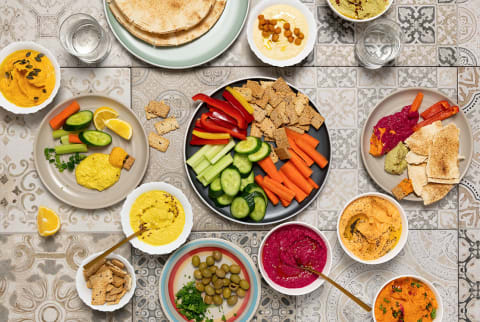
Image by Pixel Stories / Stocksy
October 19, 2023
We carefully vet all products and services featured on mindbodygreen using our
Our selections are never influenced by the commissions earned from our links.
What’s the secret to vibrant eye health? As an integrative neuro-ophthalmologist, I get this question from patients a lot. And over years of research and practice, I have come to a simple yet profound realization: the key to optimal vision lies in the colors on your plate.
Picture a plate adorned with a rainbow of different hues: It turns out each one represents a unique nutrient that’s vital for your eyes. Here’s the science behind why you should load your plate with colorful foods, and some tips to help you eat the rainbow all year long.
Why are colorful foods so good for your eyes?
For instance, the deep orange color of pumpkin, sweet potato, and butternut squash indicates the presence of carotenoids such as beta-carotene. Beta-carotene is a precursor to vitamin A, which is essential for maintaining night vision and preventing dry eye. Orange carrots also provide beta-carotene, while other varieties of carrots, such as purple, yellow, and white, provide their own unique eye-supporting nutrients.
Other orange foods, such as orange bell peppers, peaches, and nectarines, and yellow foods, like corn, egg yolk, and yellow bell peppers, get their vibrant colors from specific antioxidant eye nutrients. These orange and yellow pigmented nutrients are the xanthophyll or macular carotenoids, more commonly known as lutein and zeaxanthin.
The macular carotenoids are deposited in the back of the eye and are crucial for maintaining 20/20 vision and fighting off conditions like age-related macular degeneration. Lutein and zeaxanthin also help neutralize harmful wavelengths of ultraviolet (UV) and blue light, thus serving as internal sunglasses and blue blockers.
Greens, like spinach, kale, arugula, Swiss chard, and collard, mustard, or dandelion greens, are also rich sources of lutein and zeaxanthin. However, instead of being yellow or orange (as most foods rich in macular carotenoids tend to be), these leafy vegetables get their vibrant green colors from chlorophyll pigments.
Colorful berries have some major eye perks, too. The deep blue, purple, or black of blueberries and blackberries come from plant-derived pigments known as anthocyanins. Anthocyanins have been shown in laboratory research to support retinal function and in clinical studies to help with eye fatigue, focusing, contrast sensitivity, and tear film stability. Bright red berries, such as strawberries and raspberries, get their vivid hues from other types of anthocyanins and carotenoids.
Summary
As you can see (pun intended!), consuming a diverse range of colors can help ensure that your eyes receive a comprehensive blend of essential nutrients, thus guarding them against common eye conditions.
My 21-color eye health challenge
So, what does this mean about how to load up your plate? In my book, I introduce the concept of the “rule of 21”. Most people eat three meals a day, seven days a week, for a total of 21 meals a week. So I recommend eating a different color with each meal, thus incorporating 21 different colors into your diet each week.
This challenge is a fun way to nourish your body while supporting your eye health for years to come. Plus, introducing more colors onto your plate can help spark creativity in the kitchen and nudge you to give new ingredients a try.
Even during colder months when fresh produce might be scarce, you can work 21 colors into each week using these tips:
- Explore frozen varieties: Frozen fruits and vegetables are excellent alternatives to fresh. They retain their nutritional value and can be used in smoothies, stir-fries, and soups, adding vibrant colors to your meals.
- Embrace the power of spices: Spices like turmeric and paprika totally count! Not only do they enhance flavor, but they also bring eye-catching hues to your dishes. Turmeric is a superstar for its anti-inflammatory properties and eye health benefits. And paprika, with its deep red-orange color, provides lutein, zeaxanthin, and other carotenoids.
- Preserve seasonal ingredients: Consider making fruit preserves in the summer or soups during the autumn season that you can store away for gloomy winter days.
- Colorful grains: Whole grains like quinoa and wild rice come in various colors, so consider looking beyond the standard white or brown the next time you shop.
- Cultivate your garden: If space and climate permit, why not grow your own fruits, vegetables, and herbs? Herbs, such as cilantro, parsley, and basil, are wonderful and underrated sources of eye nutrients.
The takeaway
Incorporating 21 colors into your meals each week is a fun and healthy lifestyle shift that promises profound benefits for your all-important eyes. Here’s to your journey toward vibrant eye health and a colorful life!


